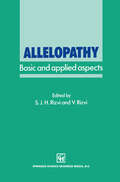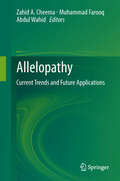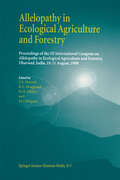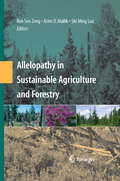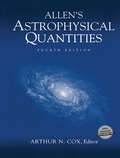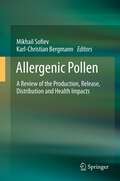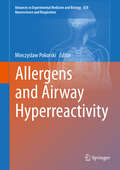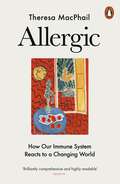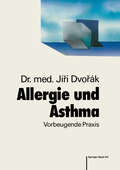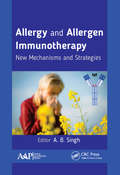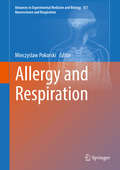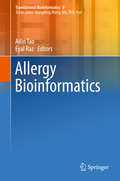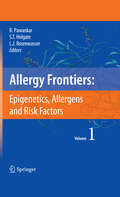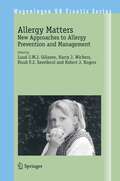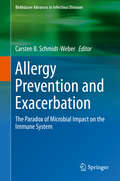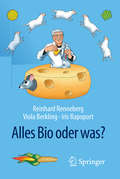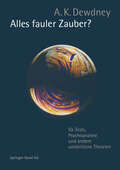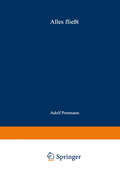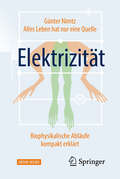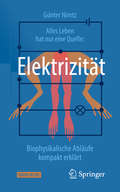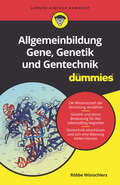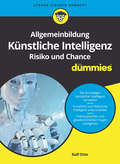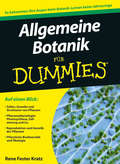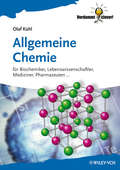- Table View
- List View
Allelopathy: Basic and applied aspects
by S. J. RizviScience is essentially a descriptive and experimental device. It observes nature, constructs hypotheses, plans experiments and proposes theories. The theory is never contemplated as the 'final truth', but remains ever subject to modifications, changes and rejections. The science of allelopathy in a similar way has emerged, and exists on a similar footing; our endeavour should be to keep it fresh and innovative with addition of newer in formation and concepts with the rejection of older ideas and antiquated techniques. During the past few decades encouraging results have been obtained in various aspects of allelopathic researches. However, in addition to continuing efforts in all these directions, constant attempts are to be made to describe the mechanics of allelopathic activity in molecular terms and to discover ways and means to exploit it for the welfare of mankind. We feel that multidisciplinary efforts are the only tool to achieve this goal. It is the hope of the editors that this book will serve as a document which identifies an integrated approach, through which research both to understand and exploit allelopathy can be conducted. The present volume arose out of an attempt to bring together eminent scientists in allelopathy to describe their work, of a highly diverse nature, under one title.
Allelopathy: Current Trends and Future Applications
by Zahid A. Cheema, Muhammad Farooq and Abdul WahidAllelopathy is an ecological phenomenon by which plants release organic chemicals (allelochemicals) into the environment influencing the growth and survival of other organisms. In this book, leading scientists in the field synthesize latest developments in allelopathy research with a special emphasis on its application in sustainable agriculture. The following topics are highlighted: Ecological implications, such as the role of allelopathy during the invasion of alien plant species; regional experiences with the application of allelopathy in agricultural systems and pest management; the use of microscopy for modeling allelopathy; allelopathy and abiotic stress tolerance; host allelopathy and arbuscular mycorrhizal fungi; allelopathic interaction with plant nutrition; and the molecular mechanisms of allelopathy. This book is an invaluable source of information for scientists, teachers and advanced students in the fields of plant physiology, agriculture, ecology, environmental sciences, and molecular biology.
Allelopathy in Ecological Agriculture and Forestry: Proceedings of the III International Congress on Allelopathy in Ecological Agriculture and Forestry, Dharwad, India, 18–21 August 1998
by S. S. Narwal R. E. Hoagland R. H. Dilday M. J. Reigosa RogerThe rapidly growing human population has increased the dependence on fossil fuel based agrochemicals such as fertilizers and pesticides to produce the required agricultural and forestry products. This has exerted a great pressure on the non renewable fossil fuel resources, which cannot last indefinitely. Besides, indiscriminate use ofpesticides for pests (weeds, insects, nematodes, pathogens) control has resulted in serious ecological and environmental problems viz. , (A) Increasing incidence of resistance in pest organisms to important pesticides. (B) Shift in pests population, particulary in weeds and insects. In weeds, species that are more closely related to the crops they infest have developed. In insects, scenario is most grim, the predators have been killed and minor insect pests have become major pests and require very heavy doses ofhighly toxic insecticides for their control. (C) Greater environmental pollution and health hazards (a) particularly from contamination of surface and underground drinking water resources and (b) from their inhalation during handling and application. (D) Toxic residues of pesticides pollute the environment and may prove hazardous to even our future generations. (E) Some agricultural commodities may contain minute quantities ofpesticides residues, with long tenn adverse effects on human and livestock health. Therefore, serious ecological questions about the reliance on pesticides for pests control has been raised. The use of fertilizers, besides causing environmental problems has also impoverished the soil health and decreased the beneficial soil fauna. For example, in some major crop rotations viz.
Allelopathy in Sustainable Agriculture and Forestry
by Ren Sen Zeng Azim U. Mallik Shiming LuoThis is the first comprehensive and up-to-date reference on the science, mechanism, methodology, and application of allelopathy. The objective of this practical reference is to report on the latest advances by inviting leading scientists to contribute in specific fields. The volume is organized under three major subsections: History of allelopathy, Allelochemicals, allelopathic mechanisms, and bioassays, and Application of allelopathy in agriculture and forestry.
Allen’s Astrophysical Quantities
by Arthur N. CoxThis new, fourth, edition of Allen's classic Astrophysical Quantities belongs on every astronomer's bookshelf. It has been thoroughly revised and brought up to date by a team of more than ninety internationally renowned astronomers and astrophysicists. While it follows the basic format of the original, this indispensable reference has grown to more than twice the size of the earlier editions to accommodate the great strides made in astronomy and astrophysics. It includes detailed tables of the most recent data on: - General constants and units - Atoms, molecules, and spectra - Observational astronomy at all wavelengths from radio to gamma-rays, and neutrinos - Planetary astronomy: Earth, planets and satellites, and solar system small bodies - The Sun, normal stars, and stars with special characteristics - Stellar populations - Cataclysmic and symbiotic variables, supernovae - Theoretical stellar evolution - Circumstellar and interstellar material - Star clusters, galaxies, quasars, and active galactic nuclei - Clusters and groups of galaxies - Cosmology. As well as much explanatory material and extensive and up-to-date bibliographies.
Allergenic Pollen: A Review of the Production, Release, Distribution and Health Impacts
by Mikhail Sofiev and Karl-Christian BergmannThis is the first book to summarize all aspects of allergenic pollen: production, atmospheric distribution, and health impacts, as well as the means of monitoring and forecasting these phenomena. Based on a four-year effort by a large group of leading European scientists, this book highlights the new developments in research on allergenic pollen, including the modelling prospects and effects of climate change. The multidisciplinary team of authors offers insights into the latest technology of detection of pollen and its allergenic properties, forecasting methods, and the influence of allergenic pollen on the population. The comprehensive coverage in this book makes it an indispensible volume for anyone dealing with allergenic pollen worldwide. Readers involved in environmental health, aerobiology, medicine, and plant science will find this book of interest.
Allergens and Airway Hyperreactivity (Advances in Experimental Medicine and Biology #838)
by Mieczyslaw PokorskiRespiratory allergy is constantly encountered and is sharply on the rise, particularly in the two most vulnerable age-groups: young children and seniors. Allergy results in airway hyperactivity and increased airway resistance, with all inflammatory sequelae being ensued. The chapters show how respiratory allergy research is interconnected with other disciplines by discussing neurotransmitter, membrane receptor, and ionic channel mechanisms of allergy and by giving diagnostic and pharmacological cues on desensitization and therapy.
Allergic: How Our Immune System Reacts to a Changing World
by Theresa MacPhailAn eye-opening investigation - combining reporting, history and cutting-edge science - into allergies and their rise in recent decadesHay fever. Peanut allergies. Eczema. Billions of people worldwide have some form of allergy; millions have one severe enough to seriously endanger their health. And over the past decade, the number of people diagnosed with allergy has been steadily increasing, an ever-growing medical burden on individuals, families, and our health care system.Medical anthropologist Theresa MacPhail, herself an allergy sufferer whose father died of a bee sting, set out to understand why. The result is a holistic and deeply researched examination of allergies, from their first medical description in 1819 to the mind-bending new treatments that are giving patients hope. MacPhail spent years interviewing hundreds of experts, patients and activists, in an effort to understand how recent changes in our environment and lifestyle are contributing to the dramatic rise in cases globally. Pollution, chemicals, antibiotics and, increasingly, climate change are all making our immune systems become more and more irritated. But, as she shows us in Allergic, understanding what is irritating us and why will help us to craft better environments in the future-so we can all breathe easier.
Allergy and Allergen Immunotherapy: New Mechanisms and Strategies
by A. B. SinghAllergy and Allergen Immunotherapy: New Mechanisms and Strategies is a valuable and comprehensive book that covers allergy and causative allergens and provides diagnostic and therapeutic aspects as well. With chapters from internationally recognized experts in the field, the book provides a balanced approach to enumerating pollen allergens as well as allergy diagnosis and therapeutic management and safety assessment of genetically engineered food allergens. The book features a special section on allergic diseases and allergens from tropical countries, including such countries such as India, Sri Lanka, Iran, and South Korea, giving the book a global appeal. The book is broken in the following sections: Epidemiology, Pathophysiology, and Diagnosis of Allergy Aerobiology and Allergic Diseases Pollen Allergy in the Tropics and Temperate Regions Allergy in Children Food Allergy Evaluation Allergen Immunotherapy and Anti IgE The book deals not only on basics of allergy and allergen immunotherapy but also discusses indoor environments and safety considerations of genetically modified food allergens. The first of its kind volume from the Indian subcontinent that caters to the needs of clinicians, aerobiologists, environmentalists, and regulatory agencies as well, the volume will be of immense interest for clinicians and patients of allergy as well as diagnostic and therapeutic management of allergy in tropics.
Allergy and Allergen Immunotherapy: New Mechanisms and Strategies
by A. B. SinghAllergy and Allergen Immunotherapy: New Mechanisms and Strategies is a valuable and comprehensive book that covers allergy and causative allergens and provides diagnostic and therapeutic aspects as well. With chapters from internationally recognized experts in the field, the book provides a balanced approach to enumerating pollen allergens as well as allergy diagnosis and therapeutic management and safety assessment of genetically engineered food allergens. The book features a special section on allergic diseases and allergens from tropical countries, including such countries such as India, Sri Lanka, Iran, and South Korea, giving the book a global appeal. The book is broken in the following sections: Epidemiology, Pathophysiology, and Diagnosis of Allergy Aerobiology and Allergic Diseases Pollen Allergy in the Tropics and Temperate Regions Allergy in Children Food Allergy Evaluation Allergen Immunotherapy and Anti IgE The book deals not only on basics of allergy and allergen immunotherapy but also discusses indoor environments and safety considerations of genetically modified food allergens. The first of its kind volume from the Indian subcontinent that caters to the needs of clinicians, aerobiologists, environmentalists, and regulatory agencies as well, the volume will be of immense interest for clinicians and patients of allergy as well as diagnostic and therapeutic management of allergy in tropics.
Allergy and Respiration (Advances in Experimental Medicine and Biology #921)
by Mieczyslaw PokorskiAllergy is an increasing health issue. It often targets the respiratory tract and entwines with respiratory ailments, which makes it difficult to discern the cause-effect linkage. Nonetheless, measures to counter the allergic background are a linchpin in preserving respiratory health. This book is an update on current advances in clinical and basic science on allergy and related topics. The diagnostics of allergy requires a multidisciplinary approach, including molecular examinations aimed at unraveling the intracellular control cascades. Chapters give insight into the innovations concerning modern pulmonary function tests, discuss pharmacological paradigms, and tackle the overlapping infectious aspects and clinical symptoms and markers. Environmental and genetic factors elicit a spectrum of inflammatory phenotypes linked to differential body responses to allergic perturbations. The book is intended for healthcare professionals, notably pulmonologists, primary care physicians, and medical researchers.
Allergy Bioinformatics (Translational Bioinformatics #8)
by Ailin Tao Eyal RazThe book introduces the bioinformatics resources and tools available for the study of allergenicity. Allergy symptoms affect more than 25% of the population in industrialized countries. At the same time, biotechnology is a rapidly developing field, which often involves the introduction of potentially allergenic novel proteins into drugs or foods. It is essential to avoid transferring a gene that encodes a major allergenic protein (from any source) into a drug/food crop that did not previously contain that protein. Accurately distinguishing candidate genes from allergens before transferring them into a drug or food would aid preventive efforts to curb the rising incidence of allergies. Several public databases have been created in response to increasing allergen data. The resources provided by these databases have paved the way for the creation of specialized bioinformatics tools that allow allergenicity to be predicted. The book is a useful resource for biologists and biomedical informatics scientists, as well as clinicians. Dr. Ailin Tao is the chief of Guangdong Province Key Laboratory of Allergy & Clinical Immunology, Principal Investigator of the State Key Laboratory of Respiratory Disease, the Second Affiliated Hospital of Guangzhou Medical University; Dr. Prof. Eyal Raz is a Professor of Medicine at University of California, San Diego, La Jolla, California, USA. They collaborate very well on allergy research and this book editing.
Allergy Frontiers:Epigenetics, Allergens and Risk Factors (Allergy Frontiers #1)
by Ruby Pawankar Stephen T. Holgate Lanny J. RosenwasserWhen I entered the field of allergy in the early 1970s, the standard textbook was a few hundred pages, and the specialty was so compact that texts were often authored entirely by a single individual and were never larger than one volume. Compare this with Allergy Frontiers: Epigenetics, Allergens, and Risk Factors, the present s- volume text with well over 150 contributors from throughout the world. This book captures the explosive growth of our specialty since the single-author textbooks referred to above. The unprecedented format of this work lies in its meticulous attention to detail yet comprehensive scope. For example, great detail is seen in manuscripts dealing with topics such as “Exosomes, naturally occurring minimal antigen presenting units” and “Neuropeptide S receptor 1 (NPSR1), an asthma susceptibility gene.” The scope is exemplified by the unique approach to disease entities normally dealt with in a single chapter in most texts. For example, anaphylaxis, a topic usually confined to one chapter in most textbooks, is given five chapters in Allergy Frontiers. This approach allows the text to employ multiple contributors for a single topic, giving the reader the advantage of being introduced to more than one vi- point regarding a single disease.
Allergy Matters: New Approaches to Allergy Prevention and Management (Wageningen UR Frontis Series #10)
by Luud J. E. J. Gilissen Harry J. Wichers Huub F. J. Savelkoul Robert J. BogersIn Western societies, the incidence and prevalence of respiratory and food-related allergies have increased rapidly over the past decades. Changes in life style, e.g. in hygiene, child vaccination, housing insulation, food consumption patterns, etc. are thought to be involved in this increase. Direct and indirect costs related to allergy are expected to rise rapidly, especially in the Central and Eastern European countries that recently joined the European Union. Major concerns relate to the significant decrease of the quality of life of patients and their relatives. This book, written by renowned experts, reflects the current ideas for future possibilities of allergy prevention, using integrated and multidisciplinary strategies and covering the entire knowledge framework from comprehensive fundamental research to implementation into society. It describes approaches from the following main topics: The medical and molecular context, The food production chain and novel foods, The living and occupational environment, People and society.
Allergy Prevention and Exacerbation: The Paradox of Microbial Impact on the Immune System (Birkhäuser Advances in Infectious Diseases)
by Carsten B. Schmidt-WeberAllergy is developing into one of the most prevalent diseases affecting individuals in the very early days of life. While the cause of this epidemic is still unclear, it appears that the westernized life style is playing an important role, which includes nutrition, possibly air pollution as well as hygienic conditions. While epidemiologic studies were able to narrow down these factors, basic research discovered novel mechanisms that control the organism´s tolerance against allergens. Particularly interesting is the role of microorganisms that colonize or infect a host and thereby cause damage and immunological activation followed by sensitization or exacerbation of already existing sensitizations. However at the same time microbial activation of the immune system can help to generate a protective immunity that prevents allergen sensitization. The current book is collecting these evidences and connects epidemiologic and clinical mechanistic knowledge. Only the synthesis of this knowledge will help to find solutions to the ongoing allergy epidemic in terms of public health activities, prevention and therapy.
Alles Bio oder was?
by Reinhard Renneberg Viola Berkling Iris RapoportIn diesem Sachbuch versammeln sich wiederum ca. 70 Biolumnen rund um Biologie und Biotechnologie. Damit ist es eine Fortsetzung der beiden Bücher Ein Löffelchen voll Biotechnologie und Biotechnologische Leckerbissen. Es sind die letzten ca. 60 Biolumnen, die in Neues Deutschland erschienen sind. Als allgemein verständliches, unterhaltsames Buch ist es für jeden geeignet, der sich für biologische aktuelle Fragestellungen interessiert.
Alles Leben hat nur eine Quelle: Biophysikalische Abläufe kompakt erklärt
by Günter NimtzWelche Bedeutung hat die Elektrizität für das Leben, insbesondere für das menschliche? Welche Rolle spielt sie für die Zellen, den Körper und seine Funktionen, für das Denken und Handeln der Menschen? Der Physiker Günter Nimtz erläutert in seinem Buch kompakt und leicht verständlich, welche Bedeutung die Elektrizität für biologische Prozesse und damit für das Leben hat.Zusammenhänge zwischen elektrischen Strömen und Lebensfunktionen wurden schon früh entdeckt. So erkannte der italienische Anatomieprofessor Luigi Galvani um das Jahr 1780 durch seine sensationellen Untersuchungen, dass elektrischer Strom Froschschenkel bewegt. Heute ist bekannt, dass die elektromagnetische Kraft und seine Wechselwirkung Ionen, Atome, Moleküle und chemische Reaktionen beherrschen. Alle lebenswichtigen Prozesse fußen auf elektrischen Signalen und deren Übertragung. Verhaltensweisen von primitivem Leben bis zu dem der Menschen erfolgen durch elektrische Impulse. Gedankenabläufe sind als elektrische Vorgänge nachweisbar.Der Autor führt kurzweilig in die physikalischen Konzepte ein und veranschaulicht an vielen Beispielen, wie Elektrizität Leben ermöglicht – von der einzelnen Körperzelle bis hin zu Funktionen des Gehirns. Damit richtet sich das Buch an alle, die sich für naturwissenschaftliche, biologische und physikalische Hintergründe des Lebens interessieren.
Alles Leben hat nur eine Quelle: Biophysikalische Abläufe kompakt erklärt
by Günter NimtzWelche Bedeutung hat die Elektrizität für das Leben, insbesondere für das menschliche? Welche Rolle spielt sie für die Zellen, den Körper und seine Funktionen, für das Denken und Handeln der Menschen? Der Physiker Günter Nimtz erläutert in seinem Buch kompakt und leicht verständlich, welche Bedeutung die Elektrizität für biologische Prozesse und damit für das Leben hat.Zusammenhänge zwischen elektrischen Strömen und Lebensfunktionen wurden schon früh entdeckt. So erkannte der italienische Anatomieprofessor Luigi Galvani um das Jahr 1780 durch seine sensationellen Untersuchungen, dass elektrischer Strom Froschschenkel bewegt. Heute ist bekannt, dass die elektromagnetische Kraft und seine Wechselwirkung Ionen, Atome, Moleküle und chemische Reaktionen beherrschen. Alle lebenswichtigen Prozesse fußen auf elektrischen Signalen und deren Übertragung. Verhaltensweisen von primitivem Leben bis zu dem der Menschen erfolgen durch elektrische Impulse. Gedankenabläufe sind als elektrische Vorgänge nachweisbar.Der Autor führt kurzweilig in die physikalischen Konzepte ein und veranschaulicht an vielen Beispielen, wie Elektrizität Leben ermöglicht – von der einzelnen Körperzelle bis hin zu Funktionen des Gehirns. Damit richtet sich das Buch an alle, die sich für naturwissenschaftliche, biologische und physikalische Hintergründe des Lebens interessieren.
Allgemeinbildung Gene, Genetik und Gentechnik für Dummies (Für Dummies)
by Röbbe WünschiersWie weit darf oder muss der Einsatz von Gentechnik gehen? Angesichts von Klimakrisen und dem Rückgang der biologischen Vielfalt müssen wir differenzierter auf neue Techniken schauen. Viele sagen, dass dies die Aufgabe der Experten sei, doch mit der Entdeckung der Genschere CRISPR/Cas rückt die Gentechnik in den Entscheidungsalltag eines jeden Einzelnen. Diagnostik, Kinderwunsch, Gentherapie? Innerhalb des gesetzlichen Rahmens muss diese Entscheidungen jeder selbst treffen. Röbbe Wünschiers bietet Ihnen mit seinem Buch "Allgemeinbildung Gene, Genetik und Gentechnik für Dummies" eine neutrale Einführung in die Gentechnik und deren Bedeutung für Ihren Lebensalltag. Die Debatte um die Anwendung der Gentechnik spaltet die Gesellschaft, doch die Wichtigkeit dieser Debatte ist unumgänglich. Lernen Sie mehr über dieses spannende Thema und bilden Sie sich eine eigene Meinung.
Allgemeinbildung Künstliche Intelligenz. Risiko und Chance für Dummies (Für Dummies)
by Ralf OtteSie haben schon oft von Künstlicher Intelligenz gelesen, finden das Thema spannend und wollen mehr darüber erfahren? Dann ist dieses Buch genau das richtige für Sie. Extra für Laien geschrieben erklärt Ihnen Professor Ralf Otte, was es mit Künstlicher Intelligenz auf sich hat. Er erläutert systematisch und allgemein verständlich die technischen Grundlagen und geht auf aktuelle Anwendungen und neue Möglichkeiten in der Zukunft ein. Zudem führt er Sie in wichtige gesellschaftliche und philosophische Fragen ein, die die Künstliche Intelligenz mittlerweile aufwirft.
Allgemeine Botanik für Dummies (Für Dummies)
by Rene Fester KratzVon der Wurzel bis zum Blatt – alles, was die Botanik zu bieten hat Ohne Pflanzen wäre das Leben des Menschen auf der Erde undenkbar – sie dienen als Nahrung, Sauerstoffund Energielieferant, Baustoff und Heilmittel. Dieses Buch gibt Ihnen einen umfassenden und leicht verständ - lichen Überblick über die Botanik, von den zellbiologischen Grundlagen über die verschiedenen Pflanzen - gewebe und -strukturen bis hin zu Physiologie, Genetik, Systematik und Ökologie. Themen wie Biodiversität, Biotechnologie und die Bedeutung von Pflanzen für den Menschen runden das Buch ab. So ist Allgemeine Botanik für Dummies das Richtige für Sie – egal ob Sie studieren oder sich einfach für Botanik interessieren.
Allgemeine Chemie: für Biochemiker Lebenswissenschaftler, Mediziner, Pharmazeuten... (Verdammt clever!)
by Olaf KühlKompakt und »verdammt clever« auf den Punkt gebracht - so gelingt mit diesem klar strukturierten Lehrbuch der optimale Einstieg in die Grundlagen der Chemie. Nicht nur für angehende Chemiker, Biochemiker und Chemieingenieure, sondern auch für alle Studierenden der Lebenswissenschaften, Medizin und Pharmazie ist die allgemeine Chemie Voraussetzung für das Verstehen von Sachverhalten benachbarter wissenschaftlicher Disziplinen. Mit dem Blick aufs Wesentliche gerichtet, sind alle prüfungsrelevanten Lerninhalte wie der Aufbau des Periodensystems, Bindungskonzepte, Säure-Base und Redoxreaktionen und vieles mehr äußerst verständlich erklärt und abgedeckt. Dabei unterstützen besondere Textelemente Ihren Lernerfolg: * Für inhaltliche Orientierung sorgen optisch hervorgehobene Schlüsselthemen am Kapitelanfang. * Das Wichtigste wird kurz und prägnant in Definitionen und Merksätzen zusammengefasst. * Beispiele helfen beim Anwenden des Lernstoffs. * Ideale Hilfe beim Nachschlagen von relevanten Stichworten und Begriffen bietet ein Glossar. * Wissenstest und Prüfungsvorbereitung: Aufgaben mit Lösungen helfen ungemein beim eigenständigen Überprüfen des Gelernten.
